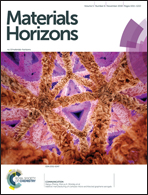A single-component hydrogel bioink for bioprinting of bioengineered 3D constructs for dermal tissue engineering†
Abstract
Bioprinting is attractive to create cellularized constructs for skin repair. However, the vast majority of bioinks present limitations in the printing of chemically defined 3D constructs with controllable biophysical and biochemical properties. To address this challenge, a single-component hydrogel bioink with a controlled density of cell-adhesive ligands, tuneable mechanical properties and adjustable rheological behaviour is developed for extrusion bioprinting and applied for the biofabrication of 3D dermal constructs. A methacrylate modified pectin bioink is designed to allow the tethering of integrin-binding motifs and the formation of hydrogels by UV photopolymerization and ionic gelation. The rheological behaviour of a low polymer concentration (1.5 wt%) solution is adjusted by ionic crosslinking, yielding a printable bioink that holds the predesigned shape upon deposition for postprinting photocrosslinking. Printed constructs provide a suitable microenvironment that supports the deposition of endogenous extracellular matrix, rich in collagen and fibronectin, by entrapped dermal fibroblasts. This approach enables the design of chemically defined and cell-responsive bioinks for tissue engineering applications and particularly for the generation of biomimetic skin constructs.



 Please wait while we load your content...
Please wait while we load your content...